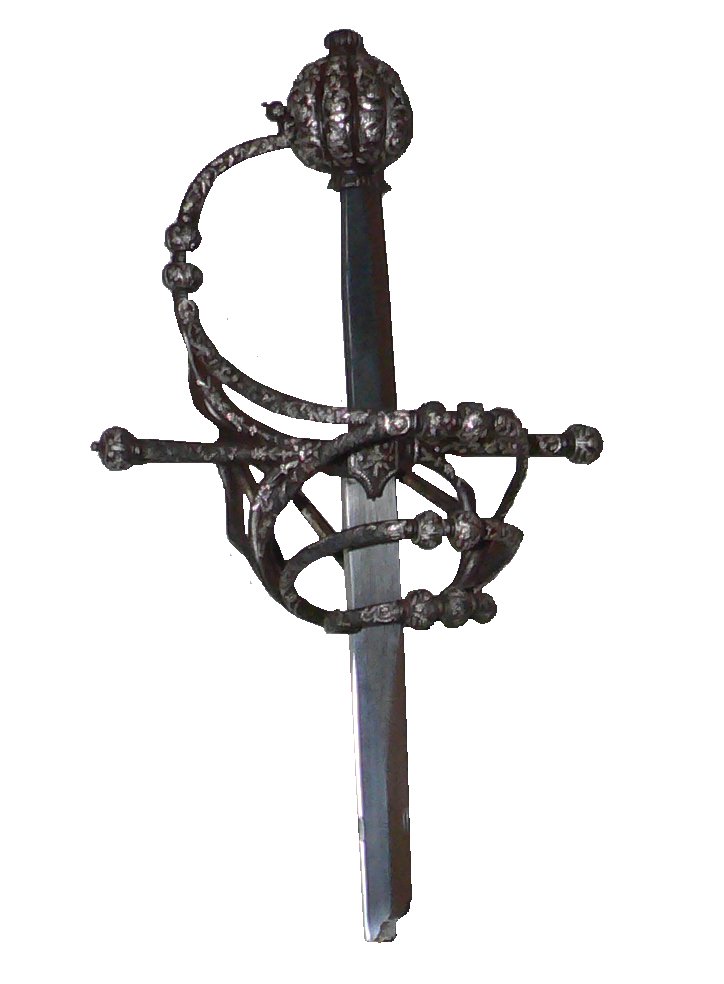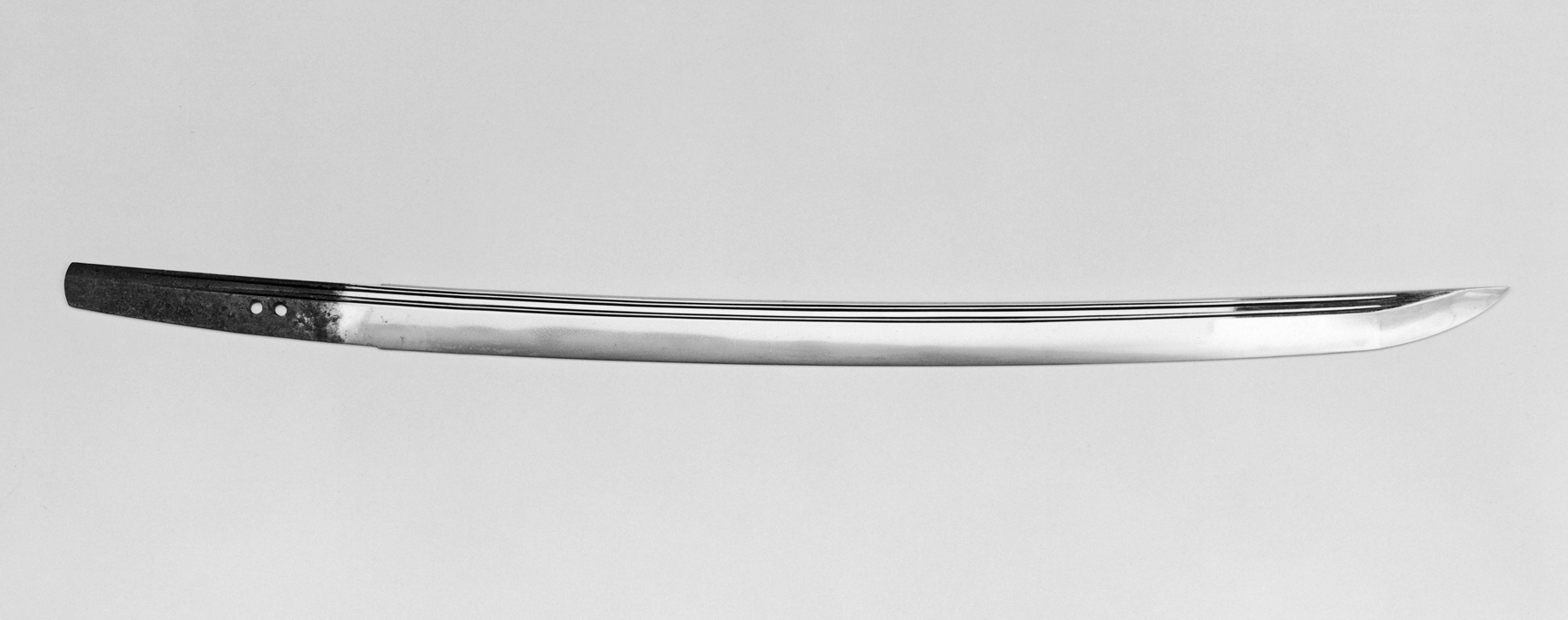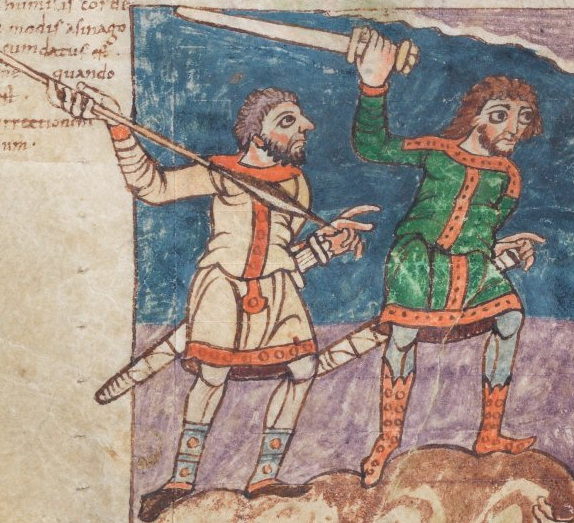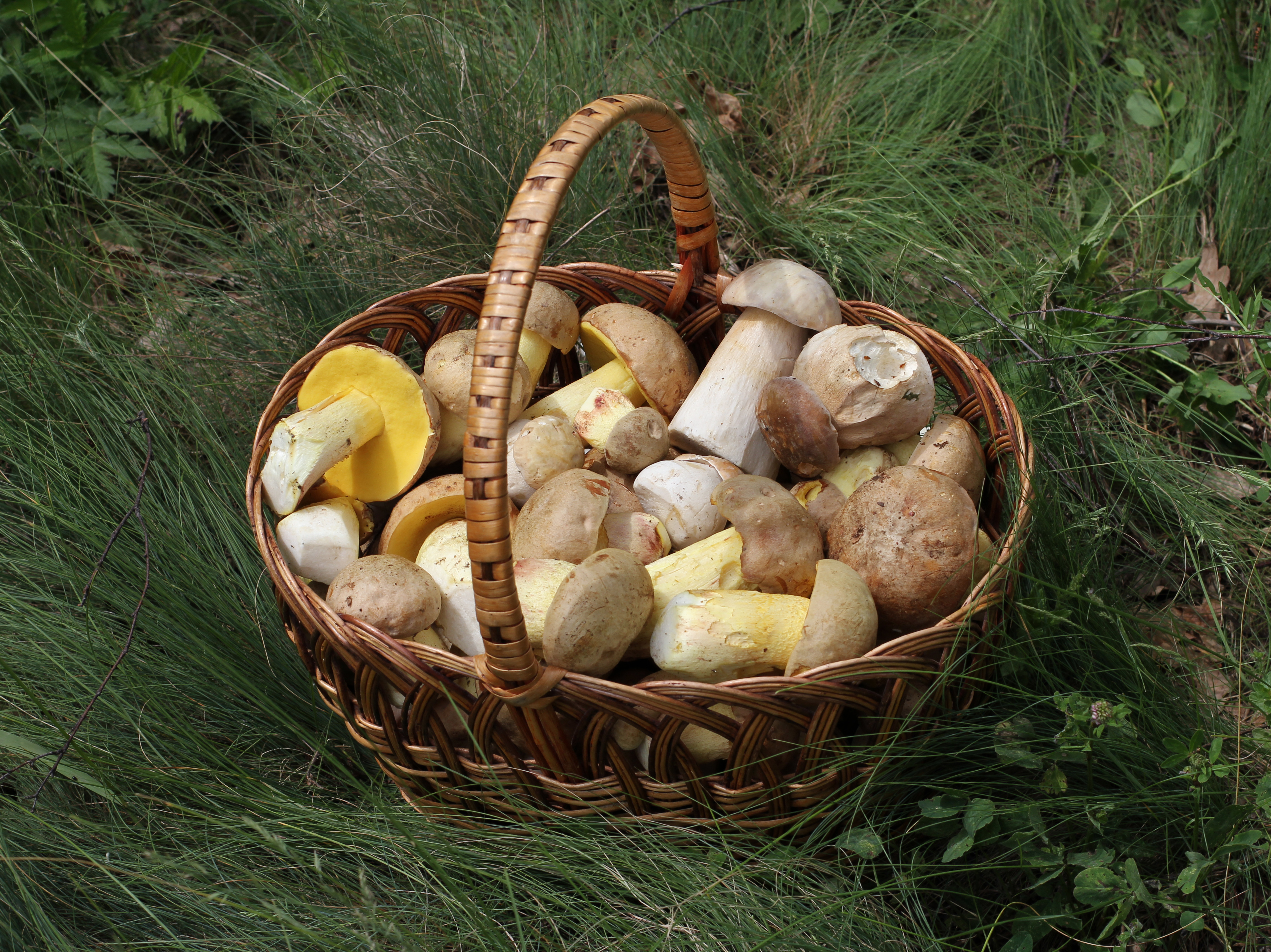|
Crossguard
A sword's crossguard or cross-guard is a bar between the blade and hilt, essentially perpendicular to them, intended to protect the wielder's hand and fingers from opponents' weapons as well as from his or her own blade. Each of the individual bars on either side is known as a quillon or quillion. History The crossguard was developed in the European sword around the 10th century for the protection of the wielder's hand. The earliest forms were the crossguard variant of the Spatha used by the Huns, the so-called Pontic swords. There are many examples of crossguards on Sasanian Persian Swords beginning from the early 3rd century. They might be the oldest examples. Crossguards were not only used to counter enemy attacks, but also to improve grip. They were later seen in late Viking swords. Crossguards are a standard feature of the Norman sword of the 11th century and of the knightly arming sword throughout the high and late medieval period. Early crossguards were straight metal ... [...More Info...] [...Related Items...] OR: [Wikipedia] [Google] [Baidu] |
Sword
A sword is an edged and bladed weapons, edged, bladed weapon intended for manual cutting or thrusting. Its blade, longer than a knife or dagger, is attached to a hilt and can be straight or curved. A thrusting sword tends to have a straighter blade with a pointed tip. A slashing sword is more likely to be curved and to have a sharpened cutting edge on one or both sides of the blade. Many swords are designed for both thrusting and slashing. The precise definition of a sword varies by historical epoch and geographic region. Historically, the sword developed in the Bronze Age, evolving from the dagger; the Bronze Age sword, earliest specimens date to about 1600 BC. The later Iron Age sword remained fairly short and without a crossguard. The spatha, as it developed in the Late Roman army, became the predecessor of the European sword of the Middle Ages, at first adopted as the Migration Period sword, and only in the High Middle Ages, developed into the classical Knightly sword, ar ... [...More Info...] [...Related Items...] OR: [Wikipedia] [Google] [Baidu] |
Hilt
The hilt (rarely called a haft or shaft) is the handle of a knife, dagger, sword, or bayonet, consisting of a guard, grip, and pommel. The guard may contain a crossguard or quillons. A tassel or sword knot may be attached to the guard or pommel. Pommel The pommel ( Anglo-Norman "little apple") is an enlarged fitting at the top of the handle. They were originally developed to prevent the sword from slipping from the hand. From around the 11th century in Europe, they became heavy enough to be a counterweight to the blade. This gave the sword a point of balance not too far from the hilt, allowing a more fluid fighting style. Depending on sword design and swordsmanship style, the pommel may also be used to strike the opponent (e.g. using the Mordhau technique). Pommels have appeared in a wide variety of shapes, including oblate spheroids, crescents, disks, wheels, and animal or bird heads. They are often engraved or inlayed with various designs and occasionally gilt and moun ... [...More Info...] [...Related Items...] OR: [Wikipedia] [Google] [Baidu] |
Arming Sword
In the European High Middle Ages, the typical sword (sometimes academically categorized as the knightly sword, arming sword, or in full, knightly arming sword) was a straight, double-edged weapon with a single-handed, cruciform (i.e., cross-shaped) hilt and a blade length of about . This type is frequently depicted in period artwork, and numerous examples have been preserved archaeologically. The high medieval sword of the Romanesque period (10th to 13th centuries) developed gradually from the Viking sword of the 9th century. In the Late Medieval period (14th and 15th centuries), late forms of these swords continued to be used, but often as a sidearm, at that point called "arming swords" and contrasting with the two-handed, heavier longswords. Though the majority of late-medieval arming swords kept their blade properties from previous centuries, there are also surviving specimens from the 15th century that took the form of a late-medieval estoc, specialised for use against mo ... [...More Info...] [...Related Items...] OR: [Wikipedia] [Google] [Baidu] |
Rain-guard
A rain-guard or chappe is a piece of leather fitted to the crossguard of European swords of the later medieval period. The purpose of this leather is not entirely clear, but it seems to have originated as a part of the scabbard, functioning as a lid when the sword was in the scabbard. The rain-guard presumably originated in the 13th century but did not become universal until the 14th. Oakeshott (1960) is aware of one preserved specimen of c. 1250. The feature was ubiquitous throughout the 15th century and into the early 16th century, but they seem to fall out of use later in the 16th century. The main problem in researching the development of this feature is the fact that it is lost to decomposition in all swords recovered archaeologically. A few originals have survived from the late medieval period; otherwise, research is largely based on depictions in paintings or etchings (e.g. well represented in works by Albrecht Dürer Albrecht Dürer ( , ;; 21 May 1471 – 6 April 1528 ... [...More Info...] [...Related Items...] OR: [Wikipedia] [Google] [Baidu] |
Medieval Dagger
A dagger is a fighting knife with a very sharp point and usually one or two sharp edges, typically designed or capable of being used as a cutting or stabbing, thrusting weapon.State v. Martin, 633 S.W.2d 80 (Mo. 1982): This is the dictionary or popular-use definition of a dagger, which has been used to describe everything from an ice pick to a folding knife with a pointed blade as a 'dagger'. The Missouri Supreme Court used the popular definition of 'dagger' found in Webster's New Universal Dictionary ("a short weapon with a sharp point used for stabbing") to rule that an ordinary pointed knife with a four- to five-inch blade constitutes a 'dagger' under the Missouri criminal code.California Penal Code 12020(a)(24):"dagger" means a ''knife or other instrument'' with or without a handguard that is ''capable of ready use as a stabbing weapon'' that may inflict great bodily injury or death. The State of California and other jurisdictions have seized upon the popular-use definition of ... [...More Info...] [...Related Items...] OR: [Wikipedia] [Google] [Baidu] |
Blade
A blade is the Sharpness (cutting), sharp, cutting portion of a tool, weapon, or machine, specifically designed to puncture, chop, slice, or scrape surfaces or materials. Blades are typically made from materials that are harder than those they are intended to cut. This includes early examples made from flaked stones like flint or obsidian, evolving through the ages into metal forms like copper, bronze, and iron, and culminating in modern versions made from steel or ceramics. Serving as one of humanity's oldest tools, blades continue to have wide-ranging applications, including in combat, cooking, and various other everyday and specialized tasks. Blades function by concentrating force at the cutting edge. Design variations, such as serrated edges found on bread knives and saws, serve to enhance this force concentration, adapting blades for specific functions and materials. Blades thus hold a significant place both historically and in contemporary society, reflecting an evolution i ... [...More Info...] [...Related Items...] OR: [Wikipedia] [Google] [Baidu] |
Spatha
The spatha was a type of straight and long sword, measuring between , with a handle length of between , in use in the territory of the Roman Empire during the 1st to 6th centuries AD. Later swords, from the 7th to 10th centuries, like the Viking swords, are recognizable derivatives and sometimes subsumed under the term ''spatha''. The Roman ''spatha'' was used in war and in gladiatorial fights. The ''spatha'' of literature appears in the Roman Empire in the 1st century AD as a weapon used by presumably Celtic auxiliaries and gradually became a standard heavy infantry weapon by the 3rd century AD, relegating the ''gladius'' to use as a light infantry weapon. The ''spatha'' apparently replaced the ''gladius'' in the front ranks, giving the infantry more reach when thrusting. While the infantry version had a long point, versions carried by the cavalry had a rounded tip that prevented accidental stabbing of the cavalryman's own foot or horse. Archaeologically many instances of the ' ... [...More Info...] [...Related Items...] OR: [Wikipedia] [Google] [Baidu] |
Huns
The Huns were a nomadic people who lived in Central Asia, the Caucasus, and Eastern Europe between the 4th and 6th centuries AD. According to European tradition, they were first reported living east of the Volga River, in an area that was part of Scythia at the time. By 370 AD, the Huns had arrived on the Volga, causing the westwards movement of Goths and Alans. By 430, they had established a vast, but short-lived, empire on the Danubian frontier of the Roman empire in Europe. Either under Hunnic hegemony, or fleeing from it, several central and eastern European peoples established kingdoms in the region, including not only Goths and Alans, but also Vandals, Gepids, Heruli, Suebians and Rugians. The Huns, especially under their King Attila, made frequent and devastating raids into the Eastern Roman Empire. In 451, they invaded the Western Roman province of Gaul, where they fought a combined army of Romans and Visigoths at the Battle of the Catalaunian Fields, and in 452, they ... [...More Info...] [...Related Items...] OR: [Wikipedia] [Google] [Baidu] |
Viking Sword
The Viking Age sword (also Viking sword) or Carolingian sword is the type of sword prevalent in Western and Northern Europe during the Early Middle Ages. The Viking Age or Carolingian-era sword developed in the 8th century from the Merovingian sword more specifically, the Frankish production of swords in the 6th to 7th century and during the 11th to 12th century in turn gave rise to the knightly sword of the Romanesque period. Terminology Although popularly called "Viking sword", this type of sword was produced in the Frankish Empire during the Carolingian era. The association of the name "Viking" with these swords is due to the disappearance of grave goods in Christian Francia in the 8th century, due to which the bulk of sword blades of Frankish manufacture of this period were found in pagan burials of Viking Age Scandinavia, imported by trade, ransom payment or looting, while continental European finds are mostly limited to stray finds in riverbeds. Swords of the 8th to ... [...More Info...] [...Related Items...] OR: [Wikipedia] [Google] [Baidu] |
Norman Sword
The spatha was a type of straight and long sword, measuring between , with a handle length of between , in use in the territory of the Roman Empire during the 1st to 6th centuries AD. Later swords, from the 7th to 10th centuries, like the Viking swords, are recognizable derivatives and sometimes subsumed under the term ''spatha''. The Roman ''spatha'' was used in war and in gladiatorial fights. The ''spatha'' of literature appears in the Roman Empire in the 1st century AD as a weapon used by presumably Celtic peoples, Celtic auxiliaries and gradually became a standard heavy infantry weapon by the 3rd century AD, relegating the ''gladius'' to use as a light infantry weapon. The ''spatha'' apparently replaced the ''gladius'' in the front ranks, giving the infantry more reach when thrusting. While the infantry version had a long point, versions carried by the Roman cavalry, cavalry had a rounded tip that prevented accidental stabbing of the cavalryman's own foot or horse. Archaeolog ... [...More Info...] [...Related Items...] OR: [Wikipedia] [Google] [Baidu] |
Basket Hilt
A basket is a container that is traditionally constructed from stiff fibers, and can be made from a range of materials, including wood splints, runners, and cane. While most baskets are made from plant materials, other materials such as horsehair, baleen, or metal wire can be used. Baskets are generally woven by hand. Some baskets are fitted with a lid, while others are left open on top. Uses Baskets serve utilitarian as well as aesthetic purposes. Some baskets are ceremonial, that is religious, in nature. While baskets are usually used for harvesting, storage and transport, specialized baskets are used as sieves for a variety of purposes, including cooking, processing seeds or grains, tossing gambling pieces, rattles, fans, fish traps, and laundry. History Prior to the invention of woven baskets, people used tree bark to make simple containers. These containers could be used to transport gathered food and other items, but crumbled after only a few uses. Weaving strips of b ... [...More Info...] [...Related Items...] OR: [Wikipedia] [Google] [Baidu] |








